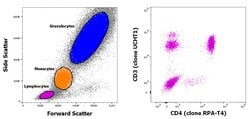Learn More
Invitrogen™ CD3/CD4 Antibody Cocktail, FITC, PE, eBioscience™
Antibody Cocktail
Supplier: Invitrogen™ 22030472

Description
Description: This product consists of two fluorochrome-conjugated monoclonal antibodies to distinguish human peripheral CD3^+ and CD4^+ T cells. The UCHT1 monoclonal antibody (mouse IgG1, kappa) reacts with human CD3e, a 20 kDa subunit of the TCR complex. Along with the other CD3 subunits gamma and delta, the epsilon chain is required for proper assembly, trafficking and surface expression of the TCR complex. CD3 is expressed by thymocytes in a developmentally regulated manner and by all mature T cells. The RPA-T4 monoclonal antibody (mouse IgG1, kappa) reacts with the human CD4 molecule, a 59 kDa cell surface receptor expressed by a majority of thymocytes, subpopulation of mature T cells (T-helper cells) and in low levels on monocytes. CD4 is a receptor for the human immunodeficiency virus (HIV). Applications Reported: This product has been reported for use in flow cytometric analysis. Applications Tested: This cocktail has been pre-titrated and tested by flow cytometric analysis of normal human peripheral blood cells. This can be used at 20 μL per test (containing 1 μg of Anti-Human CD3 (UCHT1) FITC and 0.5 μg of Anti-Human CD4 (RPA-T4) PE). A test is defined as the amount (μg) of antibody that will stain a cell sample in a final volume of 100 μL. Cell number should be determined empirically but can range from 10^5 to 10^8 cells/test.
CD3 complex is crucial in transducing antigen-recognition signals into the cytoplasm of T cells and in regulating the cell surface expression of the TCR complex. T cell activation through the antigen receptor (TCR) involves the cytoplasmic tails of the CD3 subunits CD3 gamma, CD3 delta, CD3 epsilon and CD3 zeta. These CD3 subunits are structurally related members of the immunoglobulins super family encoded by closely linked genes on human chromosome 11. The CD3 components have long cytoplasmic tails that associate with cytoplasmic signal transduction molecules. This association is mediated at least in part by a double tyrosine-based motif present in a single copy in the CD3 subunits. CD3 may play a role in TCR-induced growth arrest, cell survival and proliferation. The CD3 antigen is present on 68-82% of normal peripheral blood lymphocytes, 65-85% of thymocytes and Purkinje cells in the cerebellum. It is never expressed on B or NK cells. Decreased percentages of T lymphocytes may be observed in some autoimmune diseases. The CD4 antigen is involved in the recognition of the type II MHC antigen. It is also a receptor for HIV. It is present on most T helper cells and normal thymocytes. The cytoplasmic portion of CD4 is associated with p56lck tyrosine kinase. CD4 expression is commonly found in human lymph nodes and tonsils. CD44 is a type 1 transmembrane glycoprotein also known as Phagocytic Glycoprotein-1 (pgp-1) and HCAM. CD44 is the receptor for hyaluronate and exists as a large number of different isoforms due to alternative RNA splicing. The major isoform expressed on lymphocytes, myeloid cells, and erythrocytes is a glycosylated type 1 transmembrane protein. Other isoforms contain glycosaminoglycans and are expressed on hematopoietic and non-hematopoietic cells. CD44 is involved in adhesion of leukocytes to endothelial cells, stromal cells, and the extracellular matrix.
Specifications
| CD3/CD4 | |
| Cocktail | |
| 20 μL/Test | |
| PBS with BSA and 0.09% sodium azide; pH 7.2 | |
| P01730, P04234, P07766, P09693, P20963 | |
| CD247, CD3D, CD3E, CD3G, CD4 | |
| Affinity Chromatography | |
| RUO | |
| 915, 916, 917, 919, 920 | |
| 4°C, store in dark, DO NOT FREEZE! | |
| Liquid |
| Flow Cytometry | |
| UCHT1, RPA-T4 | |
| FITC/PE | |
| CD3G | |
| Cd247; CD247 antigen; CD247 antigen, zeta subunit; CD247 molecule; CD3 antigen delta polypeptide; CD3 antigen, delta subunit; CD3 antigen, epsilon polypeptide; CD3 antigen, gamma polypeptide; CD3 antigen, zeta polypeptide; CD3 delta; CD3 epsilon; CD3 gamma-chain; CD3 molecule delta polypeptide; CD3 molecule, delta; CD3 molecule, epsilon; CD3 molecule, epsilon polypeptide; CD3 molecule, gamma; CD3 molecule, gamma polypeptide; CD3d; CD3d antigen, delta polypeptide (TiT3 complex); CD3d molecule; CD3d molecule, delta (CD3-TCR complex); CD3-DELTA; Cd3e; CD3E antigen, epsilon polypeptide (TiT3 complex); CD3e molecule; CD3e molecule, epsilon (CD3-TCR complex); CD3-epsilon; Cd3g; CD3g antigen, gamma polypeptide (TiT3 complex); CD3g molecule; CD3g molecule, epsilon (CD3-TCR complex); CD3g molecule, gamma (CD3-TCR complex); CD3-GAMMA; CD3H; CD3Q; Cd3z; CD3Z antigen, zeta polypeptide (TiT3 complex); CD3-ZETA; CD3zeta chain; Cd4; CD4 antigen; CD4 antigen (p55); CD4 antigen p55; CD4 molecule; CD4 receptor; CD4mut; FLJ18683; IMD17; IMD18; IMD19; IMD25; Leu-2; MAL; OKT3, delta chain; OKT8 T-cell antigen; p55; T cell co-receptor; T3D; T3E; T3G; T3Z; T8 T-cell antigen; T-cell antigen Leu2; T-cell antigen receptor complex, epsilon subunit of T3; T-cell antigen receptor complex, gamma subunit of T3; T-cell antigen receptor complex, zeta subunit of CD3; T-cell receptor CD3 subunit zeta; T-cell receptor CD3, subunit zeta; T-cell receptor T3 delta chain; T-cell receptor T3 gamma chain; T-cell receptor T3 zeta chain; T-cell surface antigen T3/Leu-4 epsilon chain; T-cell surface antigen T4/Leu-3; T-cell surface glycoprotein CD3 delta chain; T-cell surface glycoprotein CD3 epsilon chain; T-cell surface glycoprotein CD3 gamma chain; T-cell surface glycoprotein CD3 zeta chain; T-cell surface glycoprotein CD4; TCR zeta chain; TCRE; TCRZ; TCRzeta; W3/25; W3/25 antigen | |
| Mouse | |
| 50 Tests | |
| Primary | |
| Human | |
| Antibody | |
| IgG1 κ |
The Fisher Scientific Encompass Program offers items which are not part of our distribution portfolio. These products typically do not have pictures or detailed descriptions. However, we are committed to improving your shopping experience. Please use the form below to provide feedback related to the content on this product.
